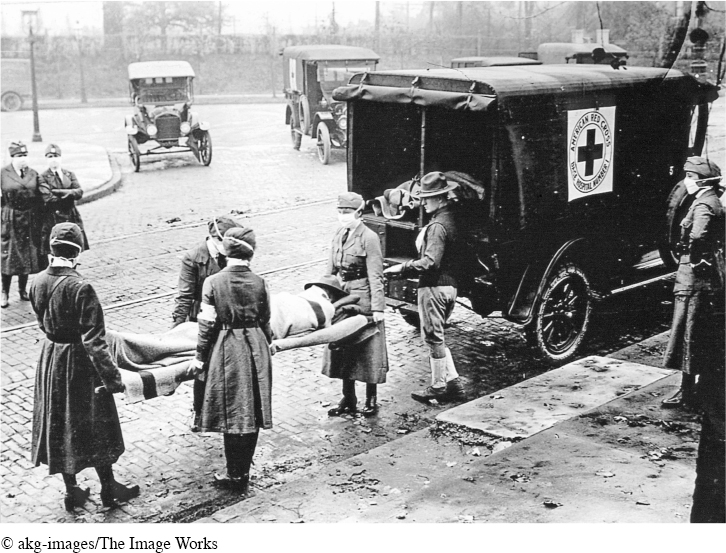The Red Scare, 1919–1920
The success of the Bolshevik Revolution in Russia in 1917 and the subsequent creation of the Union of Soviet Socialist Republics terrified officials of capitalist countries in western Europe and the United States. This fear was further exacerbated in 1919 with the creation of the Comintern, an association of Communists who pledged to incite revolution in capitalist countries around the world. This sparked a panic over Communist-inspired radicalism known as the Red scare, which set the stage for the suppression of dissent.
In this atmosphere of anxiety, on March 3, 1919, in Schenck v. United States the Supreme Court invoked the Espionage Act to uphold the conviction of Charles Schenck, the general secretary of the Socialist Party, for mailing thousands of leaflets opposing the military draft. Delivering the Court’s unanimous opinion, Justice Oliver Wendell Holmes argued that during wartime Congress has the authority to prohibit individuals from using words that create “a clear and present danger” to the safety of the country. Although the trial record failed to show that Schenck’s leaflets had convinced any young men to resist conscription, the Court upheld his conviction under Holmes’s doctrine. Later that year in Abrams v. United States, the Court further limited free speech by sustaining the guilty verdict of five anarchists who distributed leaflets denouncing U.S. military efforts to overthrow the Bolshevik regime.
Immediate postwar economic problems further increased the anxiety of American citizens, reinforcing the position of officials who sought to restore order by suppressing radicals. Industries were slow to convert their plants from military to civilian production, and consumer goods therefore remained in short supply. The war had brought jobs and higher wages on the home front, and consumers who had been restrained by wartime rationing were eager to spend their savings. With demand greatly exceeding supply, however, prices soared by 77 percent, frustrating consumers. At the same time, farmers, who had benefited from wartime conditions, faced falling crop prices as European nations resumed agricultural production and the federal government ended price supports.
A series of widespread strikes launched by labor unions in 1919 contributed to the fear that the United States was under assault by sinister, radical forces. As skyrocketing inflation undercut wages and employers launched a new round of union-busting efforts, labor went on the offensive. In 1919 more than four million workers went on strike nationwide. In September, striking Boston policemen left the city unguarded, resulting in widespread looting and violence. Massachusetts governor Calvin Coolidge sent in the National Guard to break the strike and restore order.
Public officials and newspapers decried the violence, but they also greatly exaggerated the peril. Communists and socialists did support some union activities; however, few of the millions of workers who struck for higher wages and better working conditions had ties to extremists. The major prewar radical organization, the Industrial Workers of the World, never recovered from the government harassment that had crippled it during World War I. However, scattered acts of violence allowed government and business leaders to stir up anxieties about the Communist threat. On May 1, 1919, radicals sent more than thirty incendiary devices through the mail to prominent Americans, though authorities defused the bombs before they reached their targets. The following month, bombs exploded in eight cities, including one at the doorstep of the home of A. Mitchell Palmer, the attorney general of the United States.
Explore
See Palmer’s justification for the raids in Document 21.1.
After the attack on his home, Palmer launched a government crusade to root out and prosecute Communists. Palmer traced the source of radicalism to recent immigrants, mainly those from Russia and eastern and southern Europe. To track down suspected radicals, Palmer selected J. Edgar Hoover to head the General Intelligence Division in the Department of Justice. In November 1919, based on Hoover’s research and undercover activities, government agents in twelve cities rounded up and arrested hundreds of foreigners, including the anarchist and feminist Emma Goldman. Goldman and some 250 other people caught in the government dragnet, were soon deported to Russia. Over the next few months, the Palmer raids continued in more than thirty cities. Authorities seized approximately six thousand suspected radicals, took them to police stations, interrogated them without the benefit of legal counsel, and held them incommunicado without stipulating the charges against them. Of the thousands arrested, the government found reason to deport 556. The raids did uncover any extensive plots to overthrow the U.S. government, nor did they lead to the arrest of the bombers.
Americans’ initial support of the Palmer raids quickly waned in the face of civil liberty violations that accompanied the raids. In 1920 a group of pacifists, progressives, and constitutional lawyers formed the American Civil Liberties Union (ACLU) to monitor government abridgments of the Bill of Rights. Although the Palmer raids ended, the Red scare extended throughout the 1920s. After Hoover became director of the Bureau of Investigation (later renamed the Federal Bureau of Investigation) in 1921, he continued spying and collecting information on suspected radicals and increasing his power over the next several decades.
Compounding Americans’ anxieties, in late 1918, an influenza epidemic struck the United States. Part of a worldwide contagion, the disease infected nearly 20 percent of the U.S. population and killed more than 675,000 people. As the death toll mounted over the course of 1919, terror gripped the nation. Susanna Turner, a volunteer at an emergency hospital in Philadelphia, recalled: “The fear in the hearts of people just withered them. They were afraid to go out, afraid to do anything. . . . It was a horror-stricken time.” A staggering 50 to 100 million people worldwide are estimated to have died from the flu before it subsided in 1920.

Exploring American HistoriesPrinted Page 686
Exploring American Histories Value EditionPrinted Page 506
Chapter Timeline